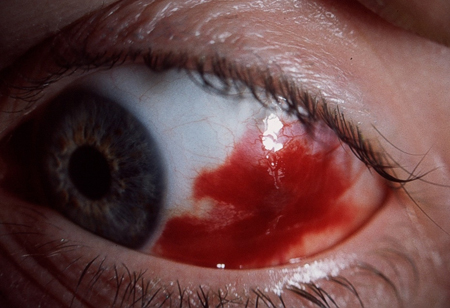Limit topical anesthetics to single use for initial symptom relief and to aid examination
Repeated use of topical anaesthetics may be toxic to the corneal epithelium and may impair healing (e.g., risks corneal melting, ring infiltrates, and infection).[32][55][56]
Topical anaesthetics can provide initial symptom relief and aid examination in patients with corneal abrasions or recurrent corneal erosions, but should be limited to single use by a medical professional.[32][55][56]
Patients should not receive topical anaesthetics for use at home.[56]
Summary
Definition
History and exam
Key diagnostic factors
- hyphaema
- ecchymosis
- severe eye pain
- blurred vision
- corneal abrasions
- corneal oedema
- sub-conjunctival haemorrhages
- corneal and conjunctival lacerations
- punctate epithelial erosions
- loss of sight
Other diagnostic factors
- excessive lacrimation
- conjunctival chemosis
- conjunctival hyperaemia
- corneal epithelial defect/abrasion
- open globe injury
- eyelid burns
- photophobia
- diplopia
- miosis
- corneal stromal clouding
- iridodialysis
- conjunctival foreign body
- corneal foreign body
- Descemet's membrane tears
- corneoscleral lacerations
- persistent headache
- loss of consciousness
- blood or clear fluid from ears or nose
- inability to move eye(s)
Risk factors
- age 18-45 years
- male sex
- no protective eyewear
- workplace injuries
- falls
- fireworks
- exposure to ultraviolet light
- previous eye surgery
- alcohol-based hand sanitisers
Diagnostic investigations
Investigations to consider
- plain x-ray
- B-scan ultrasonography
- ultrasound biomicroscopy
- optical coherence tomography
- fluorescein angiography
- fundus autofluorescence
- urine drug screen
- sickle cell trait screen
Treatment algorithm
Contributors
Authors
Fasika Woreta, MD, MPH
Associate Professor of Ophthalmology
Residency Program Director
Director, Eye Trauma Center
Wilmer Eye Institute
Johns Hopkins University School of Medicine
Baltimore
MD
Disclosures
FW declares that she has no competing interests.
Acknowledgements
Dr Fasika Woreta wishes to gratefully acknowledge Dr Ron Adelman and Dr Elena Raluca Raducu, previous contributors to this topic.
Disclosures
ERR declares that she has no competing interests.
Peer reviewers
Yewlin E. Chee, MD
Assistant Professor of Ophthalmology
University of Washington
Seattle
WA
Disclosures
YE declares that she has no competing interests.
Andrew W. Eller, MD
Professor of Ophthalmology
University of Pittsburgh School of Medicine
Pittsburgh
PA
Disclosures
AE declares that he has no competing interests.
Saloni Kapoor, MD
Clinical Assistant Professor of Medicine
UPMC Mercy Hospital
Pittsburgh
PA
Disclosures
SK declares that she has no competing interests.
Seanna Grob, MD, MAS
Assistant Professor of Ophthalmology
Oculoplastic Surgeon
University of California San Francisco
San Francisco
CA
Disclosures
SG has written a book on ocular trauma.
Use of this content is subject to our disclaimer
